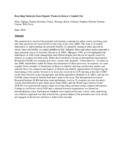| dc.contributor.author | Mary, Njenga | |
| dc.contributor.author | Dannie, Romney | |
| dc.contributor.author | Nancy, Karanja | |
| dc.contributor.author | Kuria, Gathuru | |
| dc.contributor.author | Stephen, Kimani | |
| dc.contributor.author | Sammy, Carsan | |
| dc.contributor.author | Will, Frost | |
| dc.date.accessioned | 2013-02-27T13:53:13Z | |
| dc.date.issued | 2010 | |
| dc.identifier.citation | AfG. Prain et al. (eds.), Arican Urban Harvest | en |
| dc.identifier.uri | http://erepository.uonbi.ac.ke:8080/xmlui/handle/123456789/12129 | |
| dc.description.abstract | The question how much of the potential soil nutrients contained in urban wastes are
being used and what processes are involved led to this study in the early 2000s. The
issue is of central importance to understanding the potential benefits of a properly
managed urban agriculture sector, since soil fertility is a major problem in Sub-
Saharan Africa and urban wastes represent a large potential source of nutrients
(Savala et al. 2003). Mougeot (1993, p.114) highlighted the importance of solid
waste management and offered insights into the use of organic wastes by farmers as
compost for their crops. When the Consultative Group on International Agricultural
Research (CGIAR) was starting up its new system-wide program – Urban Harvest –
in Africa in late 2000, stakeholders called for better documentation of these processes.
In response, we came together from a number of institutions in Kenya to
identify and map out the basic market and material flows for composts and manure
in Nairobi and identify opportunities for improving the functioning of the system.
Several of us were also involved in a UN meeting at the end of 2001 on the links
between waste management and urban agriculture (Kahindi et al. 2001), and the
two CGIAR centres based in Nairobi both had a stake in the issue. The International
Livestock Research Institute (ILRI) had done some preliminary work in 15 countries
on crop–livestock system intensification in peri-urban areas (Staal 2002), and
the World Agroforestry Centre (ICRAF) was interested in market chains involving
urban nurseries using compost and manure. Coming as well from a local NGO and
a national research organization, we formed an interdisciplinary team. Participatory
methods were employed because a basic value underlying our collective approach
was that research has a greater impact if the potential users of its results are engaged
in the process and have a stake in the outcome. | en |
| dc.language.iso | en | en |
| dc.publisher | International Potato Center, | en |
| dc.subject | Soil fertility | en |
| dc.subject | Urban wastes | en |
| dc.subject | Soil nutrients | en |
| dc.subject | Kenya’s Capital City | en |
| dc.title | Recycling Nutrients from OrganicWastes in Kenya’s Capital City | en |
| dc.type | Book chapter | en |
| local.publisher | Department Of Land Resource Management and Agricultural Technology, University of Nairobi | en |

